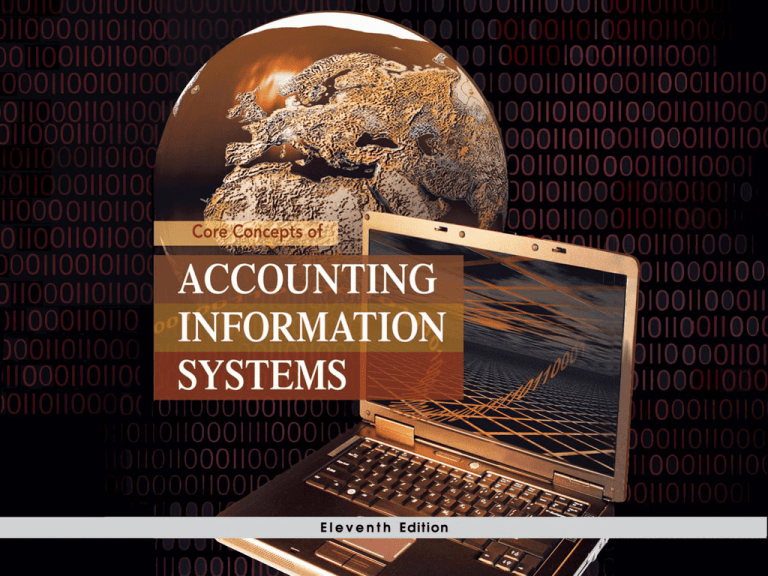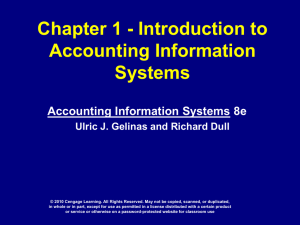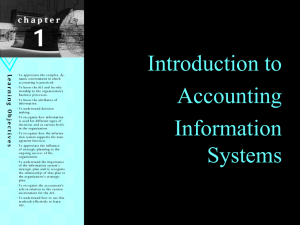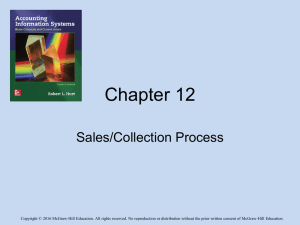
Chapter
1-1
Introduction
Applying information technology (IT) to accounting
systems
Financial accounting
Managerial accounting
Auditing
Taxation
Increased career opportunities
Specialized employment
Combine accounting and advanced computer skills
Chapter
1-2
Chapter 1:
Accounting Information Systems
and the Accountant
Introduction
Accounting Information Systems (AIS)
New Features in AIS
Accounting and IT
Careers in AIS
Chapter
1-3
AIS: The Intersection of
Accounting and IS
Chapter
1-4
Accounting Information Systems
An Accounting Information System (AIS)
Data and processing procedures
Creates needed information for users
AIS Today
Financial and non-financial data
Enterprise-wide information system
Business process focused
Chapter
1-5
The Accountant’s Challenge
Provide information to support decision-making
Business and Government processes
Accounting and Finance
Non-Accountants
Chapter
1-6
Information (versus Data)
Data
Raw facts
No organization or meaning
Beginning of audit trail
Information
Processed data
Meaningful to users
Chapter
1-7
AIS Components
Chapter
1-8
Computerized Data
Processing Problems
Information overload for users
Unable to identify input errors
Difficult to follow audit trails
Chapter
1-9
AIS and ERP
Accounting Information Systems
Internal and External users
Financial information
Enterprise Resource Planning Systems
Internal users
Financial information
Nonfinancial information
Chapter
1-10
AIS and ERP
Overlapping of the Systems
Provide same information
Emphasize business processes
Integration into seamless databases
Chapter
1-11
Study Break #1
Which of the following is likely to be information rather than
data?
A.
B.
C.
D.
Sales price
Customer number
Net profit
Employee name
Chapter
1-12
Study Break #1 - Answer
Which of the following is likely to be information rather than
data?
A.
B.
C.
D.
Sales price
Customer number
Net profit
Employee name
Chapter
1-13
Study Break #2
With respect to computerized AIS, computers:
A.
B.
C.
D.
Turn data into information in all cases
Make audit trails easier to follow
Cannot catch mistakes as well as humans
Do not generally process information more quickly than
humans
Chapter
1-14
Study Break #2 - Answer
With respect to computerized AIS, computers:
A.
B.
C.
D.
Turn data into information in all cases
Make audit trails easier to follow
Cannot catch mistakes as well as humans
Do not generally process information more quickly than
humans
Chapter
1-15
AIS: Role in Organizations
Information Age
Impact of technology
Fewer workers producing goods
Knowledge workers
Produce, analyze, manipulate, and distribute information
Focus on business activities
Chapter
1-16
AIS: Role in Organizations
E-Business
Conducting business over the Internet
Increased importance and growth
E-Commerce
Subset of e-business
Buying and selling transactions
Chapter
1-17
What’s New in AIS?
Suspicious Activity Reporting
Countering Terrorism
Corporate Scandals and Accounting
The Sarbanes-Oxley and Patriot Acts
Chapter
1-18
Suspicious Activity Reporting
Chapter
1-19
Corporate Scandals and
Accounting
Enron (2001)
Manipulation of accounting records
Understate liabilities and inflate earnings
Bernard Madoff (2008)
Investment fund manager
Ponzi scheme
$50 billion in losses
Chapter
1-20
The Sarbanes-Oxley Act of 2002
CEOs must certify the accuracy and completeness of
financial statements
Public companies must hire independent, new auditors to
review internal controls
Section 404
Implement and assess internal controls
Auditors evaluate those assessments
Chapter
1-21
Study Break #3
The Sarbanes-Oxley Act of 2002:
A. Enables U.S. officers to wire tap corporate phones if
required
B. Has lead to a decrease in the amount of work done by
auditors and accountants
C. Forbids corporations from making personal loans to
executives
D. Requires the CEO of a public company to take
responsibility for the reliability of its financial statements
Chapter
1-22
Study Break #3 - Answer
The Sarbanes-Oxley Act of 2002:
A. Enables U.S. officers to wire tap corporate phones if
required
B. Has lead to a decrease in the amount of work done by
auditors and accountants
C. Forbids corporations from making personal loans to
executives
D. Requires the CEO of a public company to take
responsibility for the reliability of its financial statements
Chapter
1-23
Study Break #4
The acronym SAR stands for:
A.
B.
C.
D.
Simple accounting receipts
Suspicious accounting revenue
Suspicious activity reporting
Standard accounts receivable
Chapter
1-24
Study Break #4 - Answer
The acronym SAR stands for:
A.
B.
C.
D.
Simple accounting receipts
Suspicious accounting revenue
Suspicious activity reporting
Standard accounts receivable
Chapter
1-25
Accounting and IT
Chapter
1-26
Financial Accounting
Objective of Financial Accounting
Provide relevant information
External parties (Investors, Creditors)
Financial Statements
The Audit Trail
Traces the accounting cycle
Data flow from input to output
Chapter
1-27
A Financial Accounting
Audit Trail
Chapter
1-28
Financial Accounting
Non-Financial Data
REA Accounting
Resources, Events, and Agents
Real-Time Reporting
Interactive Data and XBRL
Reusable data in multiple applications
“Tagging” data
Chapter
1-29
Managerial Accounting
Objective
Provide relevant information
Internal users (Managers)
Components
Cost Accounting
Budgeting
Chapter
1-30
Features of Managerial
Accounting
Chapter
1-31
Cost Accounting
Measure and Control Costs
Acquisition, processing, distribution, and selling
activities
AIS Examples
Activity-Based Costing
Corporate Performance Measurement and Business
Intelligence
Chapter
1-32
Activity-Based Costing
Assigning of Overhead
Increased automation created difficulties
Lacked direct relationship between labor and
overhead
AIS Implementation
Easier assignment of overhead
Important aspect of strategic planning
Chapter
1-33
Corporate Performance
Measurement
Responsibility Accounting System
Trace unfavorable performance to responsible
department or individuals
Immediate corrective action by managers
Balanced Scorecard
Financial Performance
Customer Knowledge
Internal Business Processes
Learning and Growth
Chapter
1-34
Business Intelligence and
Dashboards
Chapter
1-35
Budgeting
Definition
Financial projection for the future
Short-range and long-range
Usefulness
Managerial control
Compare actual and budgeted results
Chapter
1-36
Study Break #5
A dashboard is:
A. A computer screen used by data entry clerks for input
tasks
B. A physical device dedicated to AIS processing tasks
C. A summary screen typically used by managers
D. A type of blackboard used by managers to present useful
information to others
Chapter
1-37
Study Break #5 - Answer
A dashboard is:
A. A computer screen used by data entry clerks for input
tasks
B. A physical device dedicated to AIS processing tasks
C. A summary screen typically used by managers
D. A type of blackboard used by managers to present useful
information to others
Chapter
1-38
Study Break #6
Assigning overhead costs based on the resources, rather
than only direct labor, used in manufacturing is an example
of:
A.
B.
C.
D.
Activity-based costing (ABC)
Budgeting
Cost-plus accounting
Financial, rather than managerial, accounting
Chapter
1-39
Study Break #6 - Answer
Assigning overhead costs based on the resources, rather
than only direct labor, used in manufacturing is an example
of:
A.
B.
C.
D.
Activity-based costing (ABC)
Budgeting
Cost-plus accounting
Financial, rather than managerial, accounting
Chapter
1-40
Auditing
Traditional role
Evaluate the accuracy and completeness of a
corporation’s financial statements
Present role
Evaluate client’s compliance with HIPAA laws
IT evaluations and audits (security, privacy)
Management consulting
Chapter
1-41
Taxation
Taxation Software
Example of AIS
Create and evaluate tax strategies
Transmit completed forms
Professional Usage
Research challenging questions
Access more up-to-date information
Database access
Chapter
1-42
Careers in Accounting
Information Systems
Traditional Accounting
Understanding of accounting and information systems
Certified Information Technology Professional
Systems Consulting
Designing systems and reengineering processes
Software and hardware selection
Value-added resellers (VARs)
Chapter
1-43
Careers in Accounting
Information Systems
IT Auditing and Security
Risk analysis with Information Systems
Aid financial auditors in evaluation of controls
Certified Information Systems Auditors (CISAs)
Penetration testing
Chapter
1-44
AIS at Work: Consulting
Work for CPAs
Disaster Recovery Planning
Assures continuity of operations
Must test plan regularly
IT Exposure
Viruses and Worms
Auditing Standard No. 60
Report lack of disaster plan
Chapter
1-45
Copyright
Copyright 2010 John Wiley & Sons, Inc. All rights reserved.
Reproduction or translation of this work beyond that permitted in
Section 117 of the 1976 United States Copyright Act without the
express written permission of the copyright owner is unlawful.
Request for further information should be addressed to the
Permissions Department, John Wiley & Sons, Inc. The purchaser
may make backup copies for his/her own use only and not for distribution
or resale. The Publisher assumes no responsibility for errors, omissions,
or damages, caused by the use of these programs or from the use of the
information contained herein.
Chapter
1-46
Chapter 1
Chapter
1-47






